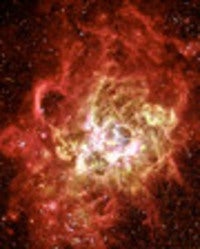I know what you’re thinking, and it’s true: In this big, crazy universe, gaseous regions with the density and heat required to ignite deuterium fusion are a dime a dozen. Any wannabe can overcome internal pressure in order to initiate gravitational collapse. But you’re dead wrong if you think I’m going to let that stop me. I’m more than some molecular cloud with the potential to have an unstable core, and I won’t just be almost undetectable molecular hydrogen forever. I’ve got what it takes. Stardom, here I come!
Here I am, stuck in some podunk H II region not even visible to the naked eye. Do I let that get me down? No way. Sure, the Horsehead and Crab Nebulas have all the star-making rep, and if you’re a young and hungry mass of interstellar dust, gas, and plasma, they say it’s not who you are, but the supernovae you know. All I need is that one Big Break to show you what I’m really made of. Point me in the direction of some cataclysmic, entropic, destabilizing explosion, and look out, Milky Way!
Yes sir, once I get that fusion of heavy hydrogen underway, there’s no holding me back. After that, it’ll only take a couple hundred millennia before I’m on the scene. Then I’m gonna outshine everything for light-years around with a candlepower unseen in this galaxy. Look, the universe is just going to have to make room for this rising circumstellar disc. After all, when you’ve got that kind of electromagnetism, everything revolves around you.
I realize the outward pressure of the resultant radiation could slow me down—happens to the hottest stars out there. But I’ll be goddamned if I muddle around in the obscurity of gradual accretion just to end up as some pathetic, ancient black dwarf that no longer even registers in the visible spectrum. When I get there, I’ll work even harder, ceaselessly raining down my remaining cloud matter until everyone recognizes me. If I just fight through all the negative energy from the bipolar flow, the solar masses of the Bok globules I create will be higher than this quadrant has ever seen. You’ll see. Twinkle, twinkle, little star? Hardly. I’m going to be hot. The hottest.
I’m going main sequence, baby. The Big Time.
But when you’re as hot as I’m going to be, there’s bound to be a downside. I’ll have to deal with constantly having my picture taken and getting my radiation, temperature, and rotation velocity routinely measured. Other, lesser bodies will try to get in my orbit and share my intense light. Any binary relationships I may have with other stars will be placed under the telescope as well. But it will all be worth it, and every body that comes in contact with me will have to understand that when the time comes to expand exponentially—well, I can’t be held responsible for those destroyed.
I know that stars that hot only last one, three million years, tops. But it’s better to explode with 100,000,000,000,000,000 times the solar luminosity than it is to fade away.
Don’t cry for me, though: My legacy will extend far beyond your lifetime. After my spectacular collapse due to hot-and-fast living, you’ll look up, and I’ll be as bright as ever. No one will even know I’m gone.
Not for at least 600 million years, anyway.







